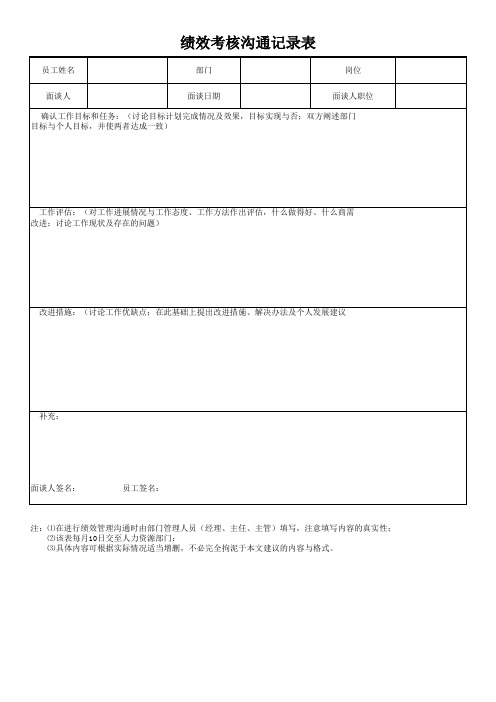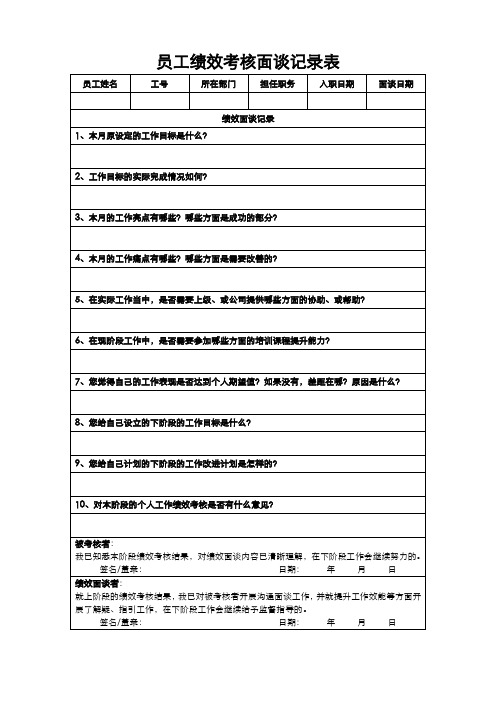最新员工绩效考核面谈记录表资料
- 格式:doc
- 大小:36.50 KB
- 文档页数:3

员工绩效考核面谈记录表
员工绩效考核面谈记录表
日期:[填写日期]
员工信息:
姓名:[填写员工姓名]
职位:[填写员工职位]
部门:[填写员工所属部门]
工号:[填写员工工号]
考核内容:
1. 工作目标达成情况:
[填写员工工作目标,以及实际达成情况的评价]
2. 工作质量与效率:
[填写员工工作质量和效率的评价,包括工作表现、完成任务的质量和速度等] 3. 团队合作与沟通能力:
[填写员工在团队合作和沟通方面的表现,包括与同事的合作关系、沟通效果等]
4. 创新与问题解决能力:
[填写员工在创新和问题解决方面的表现,包括对工作的改进和解决问题的能力等]
5. 职业素养与自我发展:
[填写员工在职业素养和自我发展方面的表现,包括工作态度、职业道德、学习能力等]
6. 其他评价:
[填写其他需要评价的内容,如员工的工作态度、工作积极性等]
综合评价:
根据以上考核内容,综合评价员工的绩效情况如下:
[填写综合评价,可以使用评级或文字描述的方式进行评价]
建议与改进:
根据员工的绩效情况,以下是对员工的建议与改进意见:
[填写对员工的建议与改进意见]
面谈人签名:[填写面谈人的姓名]
员工签名:[填写员工的姓名]
注意事项:
1. 此面谈记录表仅供内部使用,不得外传。
2. 面谈记录应真实、客观地反映员工的绩效情况,不得有主观偏见。
3. 如有需要,可在面谈记录表上附加其他相关文件或证据。



员工绩效考核面谈记录表员工绩效考核面谈记录表日期: [日期]时间: [时间]地点: [地点]被考核员工信息:姓名: [员工姓名]部门: [员工所属部门]职位: [员工职位]工号: [员工工号]考核人信息:姓名: [考核人姓名]职位: [考核人职位]工号: [考核人工号]考核目的:本次面谈旨在对员工的绩效进行全面评估,以便为员工提供准确的反馈和发展建议,同时为公司制定适当的奖励和激励计划。
面谈内容:1. 工作表现评估:- 总体评价: [评价员工的整体表现,包括工作态度、工作质量和工作效率等方面]- 优点: [列举员工在工作中表现出的优点和突出的工作成绩]- 改进空间: [指出员工在工作中存在的不足和需要改进的方面]- 建议和指导: [提供员工改进的具体建议和指导方向]2. 目标设定和进展评估:- 回顾上一次面谈设定的目标: [列举上一次面谈设定的目标]- 目标达成情况评估: [评估员工在实现目标方面的进展和成果]- 新目标设定: [根据员工的工作表现和发展需求,设定新的目标]3. 职业发展和培训需求:- 员工职业发展意愿: [了解员工对于职业发展的期望和意愿]- 职业发展规划: [与员工一起讨论并制定适合其职业发展的规划]- 培训需求评估: [评估员工在技能和知识方面的培训需求]4. 奖励和激励计划:- 奖励建议: [根据员工的工作表现和目标达成情况,提出适当的奖励建议] - 激励计划: [与员工一起制定激励计划,包括具体的奖励和激励措施]5. 面谈总结:- 员工反馈: [记录员工对于面谈内容的反馈和意见]- 面谈结果确认: [双方确认本次面谈的结果和达成的共识]- 下一步行动计划: [记录双方商定的下一步行动计划和时间表]签字:被考核员工签字: ______________________考核人签字: _________________________日期: _______________________________。


员工绩效考核面谈记录表范文员工姓名:[姓名]部门:[部门名称]职位:[职位名称]面谈日期:[具体日期]面谈人:[面谈者姓名]一、绩效考核结果概述。
1. 整体评价。
[员工姓名]啊,咱先总体说说这次考核的情况哈。
你这次的表现呢,就像是坐过山车一样,有高峰也有低谷。
整体来说呢,处于一个中上游的水平,有些方面做得相当出彩,不过也有一些地方就像鞋子里的小石子,虽然不大,但还是有点硌脚,影响了整体的发挥。
2. 关键绩效指标完成情况。
从业绩指标来看,你负责的[项目名称]完成得很不错呢。
那个项目难度可不小,就像攀登一座陡峭的山峰,你不仅成功登顶了,还在途中开辟了几条新的小路。
像[具体成果1],这可给咱们部门带来了不少的收益,这一点必须给你点个大大的赞。
但是呢,在一些日常工作任务上,就有点小马虎了。
比如说[具体任务],这就像每天都要吃的饭,虽然简单,但你偶尔也会忘做那么一两回,这可不行啊。
咱们可不能在这些基础的事情上掉链子,对吧?二、员工的工作表现与成果。
1. 工作优点。
你的工作态度那是相当积极的,就像一个充满电的小马达,每天都干劲十足。
不管遇到什么困难,你总是第一个冲上去,这种精神特别值得大家学习。
还有啊,你和团队成员之间的协作也很默契。
在[团队项目]中,你就像团队里的黏合剂,把大家紧紧地团结在一起。
你很擅长倾听别人的意见,也能很好地把自己的想法表达出来,这使得整个团队的效率提高了不少。
2. 工作不足。
不过呢,你也有个小毛病,就是有时候做事有点急。
就像开车一样,只想着快点到达目的地,却忽略了路上的一些小细节。
比如说上次[具体事例],就是因为太着急了,结果出了点小差错,虽然最后没有造成太大的损失,但也给我们敲响了警钟啊。
另外,在自我提升方面,你还得加把劲。
咱们这个行业发展得这么快,就像火箭发射一样,你要是不学习新的知识和技能,很快就会被落在后面的。
你看最近新出的[行业新技术或趋势],你好像还没有深入去了解呢。
三、员工的职业发展规划。


员工绩效考核谈话记录
员工绩效考核面谈记录表
部门/分部/处室
面谈时间
被考核者
姓名:岗位:
主管
姓名:岗位:
1、本人在本评价期内所完成工作的回顾及客观评价(含工作内容、进展与成效、不足与改进、工作成果评价、未完成的工作内容及原因分析等)
1.
2、员工在下一个评价期的工作目标、工作计划/工作安排、工作内容或上级期望
1.
3、为更好地完成本职工作和团队目标,员工在下一阶段需要努力和改善的绩效,直接主管的期望、建议、措施等
4、员工对部门(公司)工作的意见/建议、不满/抱怨、工作/生活/学习中的烦恼和困难以及希望得到的帮助/支持/指导
5、以上面谈提纲中未涉及的其他面谈内容
员工签字:主管签字:
注:查看本文相关详情请搜索进入安徽人事资料网然后站内搜索员工绩效考核谈话记录。



年度绩效面谈记录表范文一、员工基本信息。
姓名:[员工姓名]部门:[部门名称]岗位:[岗位名称]二、面谈日期。
[具体日期]三、面谈人。
[面谈人姓名]四、面谈内容。
# (一)开场寒暄。
# (二)工作成果回顾。
面:那咱先说说这一年你都干了哪些厉害的事儿。
我印象比较深的是你负责的那个[项目名称],听说最后效果超棒,你给我详细说说呗。
面:这确实很了不起啊!除了这个项目,还有其他的成果吗?比如说在日常工作里,有没有一些小的改进或者创新的地方?员:有啊,我觉得在咱们部门的工作流程上,我提出的那个关于[具体流程]的优化建议,实施之后确实提高了不少效率。
以前大家在这个环节上总是要浪费很多时间,现在就顺畅多了。
面:对,这个我也注意到了。
你这个建议就像给一辆有点卡顿的汽车加了润滑油一样,让整个流程都跑得更溜了。
那你在这一年里有没有遇到什么特别难搞的挑战呢?# (三)工作挑战与应对。
员:挑战可不少呢。
就拿[项目名称]来说吧,当时时间特别紧,任务又重,感觉就像要在不可能的时间里完成一个超级大的拼图一样。
而且中间还有一些资源不足的问题,就像做菜的时候发现盐不够了,但是又不能不做。
面:那你是怎么克服这些问题的呢?感觉你就像个超级英雄一样,总能找到办法解决难题。
员:哈哈,哪是什么超级英雄啊。
当时我就把任务按照优先级排了个序,先集中精力把最重要的部分完成。
资源不足的话,我就和其他部门协调,看能不能借一些资源来用。
然后大家也都很给力,加班加点的,总算是把这个项目给拿下了。
# (四)绩效评估。
面:你的这些努力和成果我们都看在眼里。
根据我们的绩效评估标准,在工作成果这一块,你是做得非常出色的,就像在一场考试里拿了高分一样。
但是在团队协作方面呢,虽然你和大家合作得都还不错,不过有时候沟通还可以再主动一点,就像你在球场上,有时候还可以更积极地传球一样。
你自己对这方面有什么看法呢?员:我觉得您说得对。
有时候我可能太专注于自己手头的工作了,就忽略了和团队成员的及时沟通。


附件 2:
员工绩效面谈记录表部门 /分部 / 处室面谈时间被考核者姓名:岗位:
主管姓名:
1、本人在本评价期内所完成工作的回顾及客观评价岗位:
(含工作内容、进展与成效、不足与改进、工
作成果评价、未完成的工作内容及原因分析等)
1.
2、员工在下一个评价期的工作目标、工作计划/ 工作安排、工作内容或上级期望
1.
3、为更好地完成本职工作和团队目标,员工在下一阶段需要努力和改善的绩效,直接主管的期望、
建议、措施等
4、员工对部门(公司)工作的意见 / 建议、不满 / 抱怨、工作 / 生活 / 学习中的烦恼和困难以及希望得到的帮助 /支持 / 指导
5、以上面谈提纲中未涉及的其他面谈内容
员工签字:主管签字:
员工绩效考核记录表(参考模板)
日期绩效考核事由绩效分数奖罚考核依据条款考核人签名被考核人签名。



员工绩效考核谈话记录
员工绩效考核面谈记录表
部门/分部/处室
面谈时间
被考核者
姓名:岗位:
主管
姓名:岗位:
1、本人在本评价期内所完成工作的回顾及客观评价(含工作内容、进展与成效、不足与改进、工作成果评价、未完成的工作内容及原因分析等)
1.
2、员工在下一个评价期的工作目标、工作计划/工作安排、工作内容或上级期望
1.
3、为更好地完成本职工作和团队目标,员工在下一阶段需要努力和改善的绩效,直接主管的期望、建议、措施等
4、员工对部门(公司)工作的意见/建议、不满/抱怨、工作/生活/学习中的烦恼和困难以及希望得到的帮助/支持/指导
5、以上面谈提纲中未涉及的其他面谈内容
员工签字:主管签字:
注:查看本文相关详情请搜索进入安徽人事资料网然后站内搜索员工绩效考核谈话记录。



附件 2:
员工绩效面谈记录表
部门 / 分部 / 处室面谈时间
被查核者姓名:岗位:
主管姓名:岗位:
1、自己在本评论期内所达成工作的回首及客观评论(含工作内容、进展与收效、不足与改良、工
作成就评论、未达成的工作内容及原由剖析等)
1.
2、员工在下一个评论期的工作目标、工作计划/ 工作安排、工作内容或上司希望
1.
3、为更好地达成本员工作和团队目标,员工在下一阶段需要努力和改良的绩效,直接主管的希望、
建议、举措等
4、员工对部门(企业)工作的建议/ 建议、不满 / 诉苦、工作 / 生活 / 学习中的烦忧和困难以及希望获得的帮助 / 支持 / 指导
5、以上边谈纲要中未波及的其余面谈内容
员工署名:主管署名:
员工绩效查核记录表(参照模板)
日期绩效查核事由绩效分数奖罚查核依照条款查核人署名被查核人署名。
2012年度员工绩效考核面谈记录表
管理人员签字确认:员工签字确认:Un Can you play the guitar?
撰稿:王红艳审稿:吴冬梅
词汇精讲
1. speak
speak,say,talk和tell的用法归纳:
1)speak 既可以作不及物动词也可以作及物动词,它的意思是“说、讲话”,作及物动词的时宾语是某种语言。
例如:My father is speaking. 我的爸爸在讲话。
(不及物动词)
My sister can speak French. 我的姐姐会说法语。
(及物动词)
2)say是及物动词,它的意思是“说”,后面要有说的内容。
例如:I have to say sorry to the teacher. 我不得不向那位老师道歉。
Can you say it in English? 你能用英语说吗?
3)talk意为:“交谈、谈论”,常作不及物动词。
后面用介词to/with, 表示“与……谈话/交谈”;接介词about 时表示“谈论……”;接of时表示“谈到/起……”。
例如:What are you talking about? 你们在谈论什么?
Who are you talking with? 你在和谁谈话?
4)tell的意思是“告诉、讲述”,经常用动词短语tell sb. sth. 表示“告诉某人某事”或tell sb. to do sth. 表示“告诉某人做某事”。
例如:Please tell your brother not to swim here. 请告诉你弟弟不要在这里游泳。
My grandmother often tells me some stories. 我的奶奶经常给我讲故事。
2. or
or来连接两个(或多个)并列成分。
在否定句中表示“和”的时候,通常用or。
此时,只在or前面的列举项前加no或者not,但是如果要用and连接,则or后面的列举项也要加not 或no。
例如:Do you like rice, milk, apples or bananas?
你喜欢米饭、牛奶、苹果或香蕉吗?
I have friends, but I have no sisters or brothers.。